In the eternal pursuit of market share, businesses need to keep tabs on their competitors. Without insight into their relative strengths and weaknesses, businesses will struggle to stay competitive.
In the digital world, it’s no different.
If you manage the organic search presence of a website, at one point or another, your client or boss is going to ask you for competitive SEO insights. There are many reasons they might want this:
- Staying competitive: They want to avoid falling behind.
- Finding new opportunities: They want to know what’s working for others in their niche that they may not have thought of.
- Diagnosing performance issues: They want to understand why their competitor is outranking them or getting more organic traffic.
But what exactly does this type of analysis entail?
What Should a Competitor Analysis Include?
What a competitor analysis (or “competitive analysis”) includes will depend on your unique goals.
For example, if your focus was growing your backlink profile, you could perform a competitor link analysis.
With this option, you might choose to look at a competitor’s top-linked pages to get ideas for linkable assets or analyze their referring URLs to get a better idea of what link building methods they’re using.
Search Engine Journal has some great posts detailing a few of the many different types and methods of competitor analysis, including:
- How to Spy on Competitors with Python & Data Studio
- Competitive Link Analysis: How to Audit Your Competitors’ Links
- Using Competitor Research for Content Ideation
In this article, we’ll be exploring five different methods for finding keyword ideas you can use in your organic search strategy.
By analyzing what keywords our competitors are targeting, we can come up with ideas for new content or improving existing content with the goal of capturing more organic search traffic.
Before You Start: How to Identify Your Competitors
Before diving into a competitor analysis, it’s important to know who your competitors are.
The most obvious type of competitor is the “direct” or “market” competitor. This is a business that offers the same or similar product/ service as you do. Think Coke vs. Pepsi or Nike vs. Adidas.
When you turn to Google, however, the game changes. You likely have different competitors for every keyword that’s important to your business, many of whom aren’t even your direct competitors.
Let’s take the query “How to write a cover letter” for example. Both Zety.com and GlassDoor.com are ranking prominently for the query.
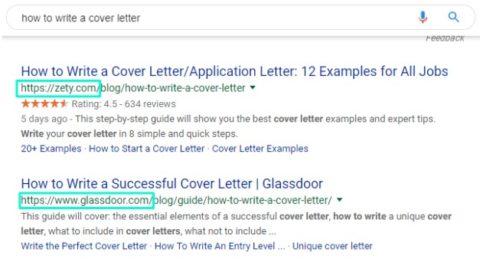
This makes them digital competitors even though Zety is a resume builder and Glass Door is a job search engine.
Sometimes your market competitors will also be your digital competitors, but not always. When the tips below call for a competitor’s domain or page, it will note what type of competitor to choose.
Now let’s dive in!
1. Find Keywords Competitors Rank for That You Don’t
One of the most-used methods of SEO competitor analysis is finding keywords that your competitors rank well for that you don’t.
To do this, you’ll want a keyword research tool that allows you to see not only what keywords are ranking for any domain, but also allows you to compare the ranking keywords of two or more domains.
As an example, let’s use market competitors ConvertKit and MailChimp. We’ll pretend ConvertKit is trying to find keywords MailChimp ranks for that they don’t.
You can use a tool like Moz’s Keyword Explorer “Explore by Site” to evaluate the ranking keywords of both domains side-by-side. (Disclosure: I work with Moz! But I also genuinely love their tools and used them long before I started working with them.)
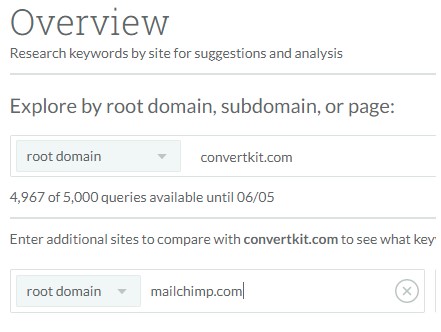
Then, select MailChimp and set the rank position to show only positions 1-10 to view keywords that MailChimp ranks on page 1 for that ConvertKit does not.
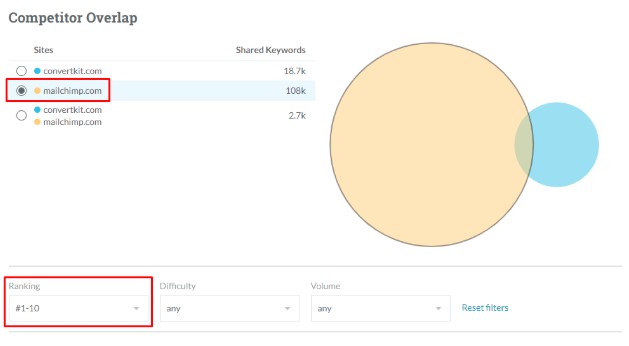
You can also select the areas of overlap in the middle to view keywords both you and a competitor rank for, and then sort by your competitor’s highest rankings. This will reveal areas where you may already have content, it just isn’t performing as well as your competitor’s.
You’ll be left with a list of keywords that shows you:
- Existing content you need to improve: Keywords you’re already targeting and just not performing very well for.
- Content gaps you might want to fill: Keywords you’re not yet targeting and might want to consider creating content for.
2. Find High-Ranking Competitor Content That Doesn’t Match Query Intent Well
Google’s priority is serving up satisfying answers to searchers’ questions. To do this, Google’s algorithm attempts to rank content that best matches the searcher intent behind the query.
I like to think of this as a “desire-content” fit. In other words, there’s a fit between what the searcher likely wanted and the content on the page. It’s exactly what the searcher wanted to find when they typed their question into Google.
For example, if you typed in “how to change a tire” you’d likely be looking for step-by-step instructions, maybe even with pictures, to guide you through that process.
A sales page for a tire store or a long-form article about tires would be much less relevant, and therefore we could say that they don’t match the intent of the query well.
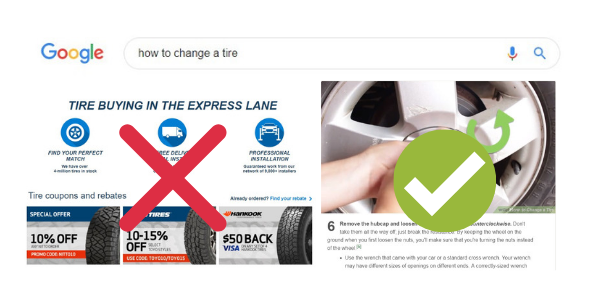
How is that helpful in the context of competitor content analysis?
Well, sometimes websites rank for queries they don’t really “deserve” to rank for. They may currently be ranking with a page that’s not a great fit for the query.
Because Google prioritizes the searcher experience, if you come along with more relevant, helpful content, there’s a likelihood that you could overtake your competitor for that query.
Again, using a keyword research tool, pop in a competitor’s domain to see what keywords they’re ranking on Page 1 for.
The next part is a bit more manual, but click to open the URLs ranking for each query and ask yourself, “If I had queried this phrase and landed on this page, would I be fully satisfied?”
If your honest answer is “no,” create a page that is.
3. Find Keywords Competitors Are Paying for That You Can Rank For
Using a tool like SEMrush, you can see what keywords your market competitors are paying for that you don’t yet rank organically for.

Why are we looking at paid keywords in a post on organic competitor analysis?
If your competitor is paying for these terms, that often means they’re valuable and generate highly qualified traffic.
Instead of paying to show up for these keywords, the idea is to see if there’s any opportunity to get free traffic by ranking organically for that term.
In many cases, the keywords you find via this route will be predominantly bottom-funnel, commercial-intent keywords. This may mean that the SERP is crowded with paid ad results and extremely powerful domains.
While there could still be some organic opportunity available, you can also look for research-intent queries containing your competitor’s paid keywords.
For example, if your competitor is running PPC for “automated email tool” you could target “how to create an automated email.”
4. Identify Valuable Topics by Looking for High-Investment Content Assets
Do you know how long it takes to produce a white paper?
How about an ebook or a webinar?
While effort varies, we can say with certainty that the barrier to entry for these content formats is typically much higher than a blog post.
Companies tend not to invest a ton of time and resources on projects that they don’t expect will generate valuable traffic and leads.
If a market competitor has chosen a topic for a big content project, consider that a pre-vetted idea that your desired customers will likely be interested in.
For example, if your competitor is hosting a webinar on “Understanding Your Cash Flow” it might be a good idea to type the phrase “cash flow” into your keyword research tool of choice and see how you could start owning that topic organically.
You can even use Google itself combined with plugins like Keywords Everywhere to find a whole bunch of topically-relevant keywords to target.

5. Find Content Improvement Ideas by Viewing Competitor Keyword Overlap
Content not ranking as well as you’d like for your target keyword? Use competitor analysis to see what topics your content might be missing!
One of my favorite ways to do this is by using Moz Keyword Explorer to compare keywords by exact page.
Say you’re trying to rank for the keyword phrase “how to run faster.” Perform a Google search for that term and grab two or three of the top-ranked URLs (your digital competitors) and pop them into the tool.
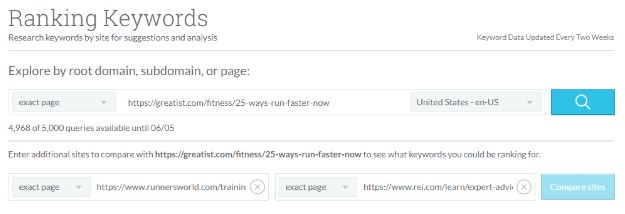
Then, click on the areas of most overlap and set the filter to view keywords ranking on page 1.
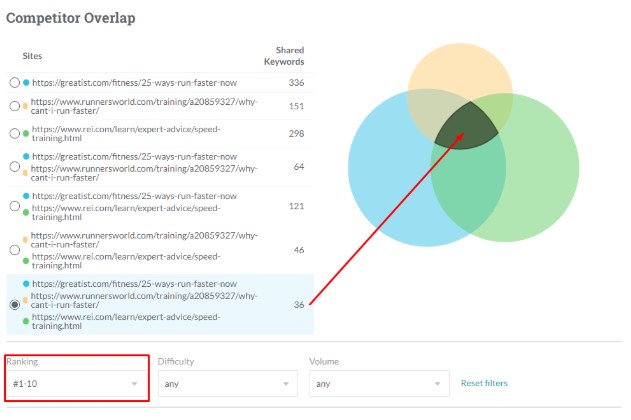
What you’ll be left with is a list of related keyword ideas that you can use to make your page targeting “how to run faster” more relevant! If Google’s top picks for the best answer to “how to run faster” also touch on these concepts, that’s an indicator that your content should too.
Go Forth & Analyze! (But Proceed With Caution)
Any of the competitor analysis methods mentioned in this article can offer great ideas for capturing more organic traffic, but there’s are some huge caveats here:
- If your only strategy is imitation, the best you’ll ever become is the second best version of your competitors.
- Plagiarism can get you into trouble: with search engines, legally, and it can ruin your reputation. Just don’t do it.
- Don’t be a lemming. Blindly following your competitors could send you straight over a cliff.
Before conducting a competitor analysis, make sure you’re familiar with the business’s current goals and priorities.
Once you do that, it’ll be much easier to identify which competitor strategies you should use to inform your own and which are best left alone.
Now the next time your client or boss asks you for a competitor analysis, I hope you have a few new tricks up your sleeve.
More Resources:
- SEO Competitive Analysis: The Definitive Guide
- Keyword Research: An In-Depth Beginner’s Guide
- 6 Unique & Free Keyword Research Tools You Didn’t Know You Needed
Image Credits
Featured Image: Pexels
All screenshots taken by author, May 2019





